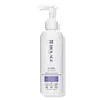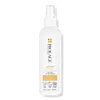What's inside
What's inside
 Key Ingredients
Key Ingredients

 Benefits
Benefits

 Concerns
Concerns

 Ingredients Side-by-side
Ingredients Side-by-side

Water
Skin ConditioningDimethicone
EmollientPropylene Glycol
HumectantPvp
Emulsion StabilisingGlycerin
HumectantSclerotium Gum
Emulsion StabilisingAmodimethicone
Behentrimonium Chloride
PreservativeSodium Benzoate
MaskingParfum
MaskingPEG/PPG-17/18 Dimethicone
EmulsifyingPotassium Sorbate
PreservativeCetyl Alcohol
EmollientIsopropyl Alcohol
SolventSodium Citrate
BufferingLaureth-23
CleansingLaureth-4
EmulsifyingAloe Barbadensis Leaf Juice
Skin ConditioningEthylhexylglycerin
Skin ConditioningDisodium EDTA
Trideceth-6
EmulsifyingLimonene
PerfumingSalicylic Acid
MaskingCetrimonium Chloride
AntimicrobialHexyl Cinnamal
PerfumingCitric Acid
BufferingCoumarin
PerfumingLinalool
PerfumingButylphenyl Methylpropional
PerfumingBenzyl Alcohol
PerfumingHydroxycitronellal
PerfumingPassiflora Edulis Fruit Juice
Skin ConditioningAmyl Cinnamal
PerfumingGeraniol
PerfumingAlpha-Isomethyl Ionone
PerfumingIsoeugenol
PerfumingBenzyl Benzoate
AntimicrobialCinnamyl Alcohol
PerfumingBisabolol
MaskingCitronellol
PerfumingWater, Dimethicone, Propylene Glycol, Pvp, Glycerin, Sclerotium Gum, Amodimethicone, Behentrimonium Chloride, Sodium Benzoate, Parfum, PEG/PPG-17/18 Dimethicone, Potassium Sorbate, Cetyl Alcohol, Isopropyl Alcohol, Sodium Citrate, Laureth-23, Laureth-4, Aloe Barbadensis Leaf Juice, Ethylhexylglycerin, Disodium EDTA, Trideceth-6, Limonene, Salicylic Acid, Cetrimonium Chloride, Hexyl Cinnamal, Citric Acid, Coumarin, Linalool, Butylphenyl Methylpropional, Benzyl Alcohol, Hydroxycitronellal, Passiflora Edulis Fruit Juice, Amyl Cinnamal, Geraniol, Alpha-Isomethyl Ionone, Isoeugenol, Benzyl Benzoate, Cinnamyl Alcohol, Bisabolol, Citronellol
Water
Skin ConditioningDimethicone
EmollientStearyl Alcohol
EmollientPhenoxyethanol
PreservativeBehentrimonium Chloride
PreservativeAmodimethicone
Isopropyl Alcohol
SolventLaureth-23
CleansingLaureth-4
EmulsifyingGlycerin
HumectantEthylhexylglycerin
Skin ConditioningTrideceth-6
EmulsifyingParfum
MaskingSalicylic Acid
MaskingAgave Tequilana Leaf Extract
AstringentTriethanolamine
BufferingCetrimonium Chloride
AntimicrobialLimonene
PerfumingHexyl Cinnamal
PerfumingCoumarin
PerfumingBenzyl Alcohol
PerfumingLinalool
PerfumingAmyl Cinnamal
PerfumingTocopherol
AntioxidantWater, Dimethicone, Stearyl Alcohol, Phenoxyethanol, Behentrimonium Chloride, Amodimethicone, Isopropyl Alcohol, Laureth-23, Laureth-4, Glycerin, Ethylhexylglycerin, Trideceth-6, Parfum, Salicylic Acid, Agave Tequilana Leaf Extract, Triethanolamine, Cetrimonium Chloride, Limonene, Hexyl Cinnamal, Coumarin, Benzyl Alcohol, Linalool, Amyl Cinnamal, Tocopherol
Ingredients Explained
These ingredients are found in both products.
Ingredients higher up in an ingredient list are typically present in a larger amount.
This water-soluble silicone is used for its hydrating and softening properties. It is used to add a silky feel to skincare products and has great benefits for haircare.
In haircare, this ingredient:
- Adds shine
- Protects color
- Offers thermal protection
- Boosts hair strength
- Does not build up as easily
Amyl Cinnamal is a synthetically produced fragrance. Its scent is reminiscent of jasmine flowers.
Amyl Cinnamal is a known EU allergen. This means it is known to cause skin sensitivity and allergies.
This ingredient is a preservative and often used for it's anti-static properties. You'll most likely see this ingredient in hair conditioners.
It does not cause irritation or sensitization in leave-on products at 1-5%.
Benzyl Alcohol is most commonly used as a preservative. It also has a subtle, sweet smell. Small amounts of Benzyl Alcohol is not irritating and safe to use in skincare products. Most Benzyl Alcohol is derived from fruits such as apricots.
Benzyl Alcohol has both antibacterial and antioxidant properties. These properties help lengthen the shelf life of products. Benzyl Alcohol is a solvent and helps dissolve other ingredients. It can also improve the texture and spreadability.
Alcohol comes in many different forms. Different types of alcohol will have different effects on skin. This ingredient is an astringent alcohol.
Using high concentrations of these alcohols are drying on the skin. They may strip away your skin's natural oils and even damage your skin barrier. Astringent alcohols may also irritate skin.
Other types of astringent alcohols include:
According to the National Rosacea Society based in the US, you should be mindful of products with these alcohols in the top half of ingredients.
Any type of sanitizing product will have high amounts of alcohol to help kill bacteria and viruses.
Learn more about Benzyl AlcoholThis ingredient is a preservative, antimicrobial, and emulsifier. It is often used in cosmetics for its ability to cleanse, condition, and reduce static.
Cetrimonium chloride is a quaternary ammonium salt, meaning it has a water-soluble structure.
Coumarins are a group of substances found naturally in plants. There are over 1300 types of coumarins identified. It has a natural vanilla scent.
Coumarin is an identified EU known allergy, meaning it may cause an allergic reaction when applied to the skin.
In many countries, coumarin is banned as a food additive. However, it can be found in soaps, tobacco products, and some alcohol drinks.
Plants use coumarins as a chemical defense. Some plants that have coumarins include lavender, tonka beans, and yellow clovers.
Learn more about CoumarinDimethicone is a type of synthetic silicone created from natural materials such as quartz.
What it does:
Dimethicone comes in different viscosities:
Depending on the viscosity, dimethicone has different properties.
Ingredients lists don't always show which type is used, so we recommend reaching out to the brand if you have questions about the viscosity.
This ingredient is unlikely to cause irritation because it does not get absorbed into skin. However, people with silicone allergies should be careful about using this ingredient.
Note: Dimethicone may contribute to pilling. This is because it is not oil or water soluble, so pilling may occur when layered with products. When mixed with heavy oils in a formula, the outcome is also quite greasy.
Learn more about DimethiconeEthylhexylglycerin (we can't pronounce this either) is commonly used as a preservative and skin softener. It is derived from glyceryl.
You might see Ethylhexylglycerin often paired with other preservatives such as phenoxyethanol. Ethylhexylglycerin has been found to increase the effectiveness of these other preservatives.
Glycerin is already naturally found in your skin. It helps moisturize and protect your skin.
A study from 2016 found glycerin to be more effective as a humectant than AHAs and hyaluronic acid.
As a humectant, it helps the skin stay hydrated by pulling moisture to your skin. The low molecular weight of glycerin allows it to pull moisture into the deeper layers of your skin.
Hydrated skin improves your skin barrier; Your skin barrier helps protect against irritants and bacteria.
Glycerin has also been found to have antimicrobial and antiviral properties. Due to these properties, glycerin is often used in wound and burn treatments.
In cosmetics, glycerin is usually derived from plants such as soybean or palm. However, it can also be sourced from animals, such as tallow or animal fat.
This ingredient is organic, colorless, odorless, and non-toxic.
Glycerin is the name for this ingredient in American English. British English uses Glycerol/Glycerine.
Learn more about GlycerinHexyl Cinnamal is a fragrance ingredient with a similar scent to jasmine. It can be naturally found in chamomile essential oil.
This ingredient is a known EU allergen and may sensitize the skin. The EU requires this ingredient to be listed separately on an ingredients list.
Hexyl Cinnamal is not water soluble but is soluble in oils.
Learn more about Hexyl CinnamalIsopropyl Alcohol is more commonly known as rubbing alcohol. It is most commonly used as a solvent, meaning it helps other ingredients dissolve.
This ingredient is an astringent alcohol. Astringent alcohols may also irritate skin as they high amounts may strip away your skin's natural oils.
Other types of astringent alcohols include:
According to the National Rosacea Society based in the US, you should be mindful of products with these alcohols in the top half of ingredients.
Any type of sanitizing product will have high amounts of alcohol to help kill bacteria and viruses.
Learn more about Isopropyl AlcoholLaureth-23 is created by reacting ethylene oxide with Lauryl Alcohol.
It is a cleansing ingredient. This means it helps lift oils and dirt so they may be rinsed away with water.
The 23 refers to the number of repeating ethylene oxides in the molecule.
Learn more about Laureth-23Laureth-4 is created by reacting ethylene oxide with Lauryl Alcohol. It is a surfactant and emulsifier.
Surfactants reduce the surface tension of ingredients so they can mix better. Emulsifiers prevent ingredients such as oil and water from separating.
Limonene is a fragrance that adds scent and taste to a formulation.
It's found in the peel oil of citrus fruits and other plants such as lavender and eucalyptus. The scent of limonene is generally described as "sweet citrus".
Limonene acts as an antioxidant, meaning it helps neutralize free radicals.
When exposed to air, oxidized limonene may sensitize the skin. Because of this, limonene is often avoided by people with sensitive skin.
The term 'fragrance' is not regulated in many countries. In many cases, it is up to the brand to define this term. For instance, many brands choose to label themselves as "fragrance-free" because they are not using synthetic fragrances. However, their products may still contain ingredients such as essential oils that are considered a fragrance.
Learn more about LimoneneLinalool is a fragrance and helps add scent to products. It's derived from common plants such as cinnamon, mint, citrus, and lavender.
Like Limonene, this ingredient oxidizes when exposed to air. Oxidized linalool can cause allergies and skin sensitivity.
This ingredient has a scent that is floral, spicy tropical, and citrus-like.
Learn more about LinaloolParfum is a catch-all term for an ingredient or more that is used to give a scent to products.
Also called "fragrance", this ingredient can be a blend of hundreds of chemicals or plant oils. This means every product with "fragrance" or "parfum" in the ingredients list is a different mixture.
For instance, Habanolide is a proprietary trade name for a specific aroma chemical. When used as a fragrance ingredient in cosmetics, most aroma chemicals fall under the broad labeling category of “FRAGRANCE” or “PARFUM” according to EU and US regulations.
The term 'parfum' or 'fragrance' is not regulated in many countries. In many cases, it is up to the brand to define this term.
For instance, many brands choose to label themselves as "fragrance-free" because they are not using synthetic fragrances. However, their products may still contain ingredients such as essential oils that are considered a fragrance by INCI standards.
One example is Calendula flower extract. Calendula is an essential oil that still imparts a scent or 'fragrance'.
Depending on the blend, the ingredients in the mixture can cause allergies and sensitivities on the skin. Some ingredients that are known EU allergens include linalool and citronellol.
Parfum can also be used to mask or cover an unpleasant scent.
The bottom line is: not all fragrances/parfum/ingredients are created equally. If you are worried about fragrances, we recommend taking a closer look at an ingredient. And of course, we always recommend speaking with a professional.
Learn more about ParfumSalicylic Acid (also known as beta hydroxy acid or BHA) is a well-known ingredient for treating skin that struggles with acne and clogged pores. It exfoliates both the skin's surface and deep within the pores to help clear out buildup, control oil, and reduce inflammation.
Unlike AHAs (alpha hydroxy acids), salicylic acid is oil-soluble. This allows it to penetrate into pores which makes it especially effective for treating blackheads and preventing future breakouts.
Salicylic acid is also known for its soothing properties. It has a similar structure to aspirin and can calm inflamed or irritated skin, making it a good option for acne-prone skin that is also sensitive.
Concentrations of 0.5-2% are recognized by the U.S. FDA as an over-the-counter topical acne product.
It can cause irritation and/or dryness if one's skin already has a compromised moisture barrier, so it's best to focus on repairing that before introducing this ingredient into your routine.
While salicylic acid does not increase sun sensitivity, it’s still important to wear sunscreen daily to protect your skin.
If you are looking for the ingredient called BHA or Butylated Hydroxyanisole, click here.
Learn more about Salicylic AcidWe don't have a description for Trideceth-6 yet.
Water. It's the most common cosmetic ingredient of all. You'll usually see it at the top of ingredient lists, meaning that it makes up the largest part of the product.
So why is it so popular? Water most often acts as a solvent - this means that it helps dissolve other ingredients into the formulation.
You'll also recognize water as that liquid we all need to stay alive. If you see this, drink a glass of water. Stay hydrated!
Learn more about Water